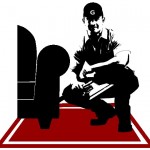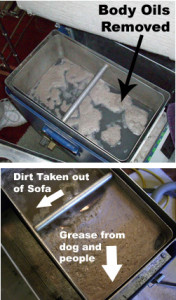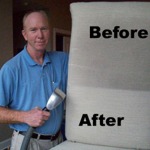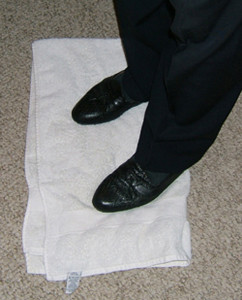 Cleaning Upholstery takes a level of expertise way beyond the typical carpet cleaner. This is due to the type of dirt involved, the different shapes of furniture and the different fabrics used.
Cleaning Upholstery takes a level of expertise way beyond the typical carpet cleaner. This is due to the type of dirt involved, the different shapes of furniture and the different fabrics used.
Upholstery dirt is primarily people and pet issues. People shed dead skin cells, hair and hair dander along with sweat and body oils through exposed skin. Cosmetics, hair sprays and other beauty items get on upholstery. Plus, children and parties increase the likelihood of spills. If you have animals, their hair, body oils and dander are probably getting on your furniture. Over time, all these tend to accumulate into the fabric.
 Furniture designs and styles contribute different degrees of difficulty to clean. An easy working surface is a flat one. However, furniture has many corners and edges which make the application of cleaning solutions and the removal of the associated dirt very difficult. Skill and experience are required to effectively clean these areas.
Furniture designs and styles contribute different degrees of difficulty to clean. An easy working surface is a flat one. However, furniture has many corners and edges which make the application of cleaning solutions and the removal of the associated dirt very difficult. Skill and experience are required to effectively clean these areas.
 Upholstery also uses many different types of fabrics than carpet or rugs ranging from natural materials like silk to synthetics like nylon. Having a cleaner who knows what they are doing is extremely important. For example, many companies will not clean silk because of the potential for splotching or streaking to occur. Also, if not properly cleaned, white furniture, especially cottons and wools, can turn brown.
Upholstery also uses many different types of fabrics than carpet or rugs ranging from natural materials like silk to synthetics like nylon. Having a cleaner who knows what they are doing is extremely important. For example, many companies will not clean silk because of the potential for splotching or streaking to occur. Also, if not properly cleaned, white furniture, especially cottons and wools, can turn brown.
Typically, people clean their furniture to look better. However, if it is something you plan on keeping, periodic cleaning to remove the impacted dirt is advised. It is like your clothes, even though they may not look dirty, you wash them to remove the dirt and soil from use.
For more information, visit my website at www.graysoncleans.com



